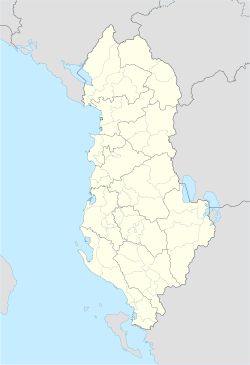Klenjë (Macedonian: Клење) is a village in the former Trebisht Municipality in Dibër County in northeastern Albania. At the 2015 local government reform it became part of the municipality Bulqizë.[1] It is situated with in the Gollobordë region, near the border with North Macedonia.
Klenjë
Клење | |
|---|---|
| Coordinates: 41°22′04″N 20°28′11″E / 41.36778°N 20.46972°E | |
| Country | |
| County | Dibër |
| Municipality | Bulqizë |
| Municipal unit | Trebisht |
| Population (2007) | |
• Total | 207 |
| Time zone | UTC+1 (CET) |
| • Summer (DST) | UTC+2 (CEST) |
History
editDuring the Balkan Wars, one man from the village joined the Macedonian-Adrianopolitan Volunteer Corps in Bulgarian Army.[2]
Demographic history
editKlenjë (Kilani) is recorded in the Ottoman defter of 1467 as a settlement in the timar of Hacı Hamza in the vilayet of Dulgoberda. The village had a total of three households represented by Dimitri Susjabi (possibly, Sycjapi); Gjurçe, the grandson or brother-in-law of Dimitri; and Miho Tishani. The surname Susjabi is likely a compound of Albanian sy ("eye") + cjap ("billy goat").[3]
A Bulgarian demographic survey of the population of the village, done in 1873, recorded the village as having 100 households with 196 male Bulgarian Christian residents and 120 male Muslim (Pomak) residents.[4]
According to statistics gathered by Vasil Kanchov in 1900, the village of Klenjë was inhabited by 1240 Christian Bulgarians and 230 Muslim Bulgarians. However, Kanchov noted that the inhabitants of the village preferred to be called Albanians and that they spoke Albanian.[5]
The inhabitants of Klenjë are speakers of an Eastern South Slavic language[6] and the village has traditionally contained a Torbeš[7] population.
According to a 2007 estimate, Klenjë's population was 207.[8]
People from Klenjë
edit- Cvetan Zafir Mazniku, author in Macedonian-Albanian folklore topics[9]
- Sterjo Budin Budini, master builder and member of National Assembly for three consecutive legislatures (1962-1974).[10]
References
edit- ^ "Law nr. 115/2014" (PDF) (in Albanian). p. 6367. Retrieved 25 February 2022.
- ^ „Македоно-одринското опълчение 1912-1913 г. Личен състав“, Главно управление на архивите, 2006, стр.589.
- ^ Caka, Eduart (2019). Defteri i hollësishëm për zonat e dibrës i vitit 1467. Tiranë: Akademia e studimeve albanologjike instituti historisë. p. 108.
- ^ „Македония и Одринско. Статистика на населението от 1873 г.“ Македонски научен институт, София, 1995, стр.172-173.
- ^ Vasil Kanchov (1900). Macedonia: Ethnography and Statistics. Sofia. p. Жителите на селата Острени (Големо и Мало), Трново (Големо и Мало), Клење, Летен, Џепишта, Ербеле, Обоки, Макелари и др. претпочитат да се изјаснуваат како Арнаути и да зборуваат арнаутски.[4] pg. 90
- ^ Steinke, Klaus; Ylli, Xhelal (2008). Die slavischen Minderheiten in Albanien (SMA): Golloborda - Herbel - Kërçishti i Epërm. Teil 2. Munich: Verlag Otto Sagner. p. 10. ISBN 9783866880351. "Heute umfaßt das Gebiet von Golloborda in Albanien 22 Dörfer, die verwaltungstechnisch auf drei verschiedene Gemeinden aufgeteilt sind: 1. Die Gemeinde Ostren besteht aus dreizehn Dörfern, und Südslavisch wird in den folgenden neun Dörfern gesprochen: Ostreni i Madh (Golemo Ostreni/Ostreni Golemo), Kojavec (Kojovci), Lejçan (Lešničani), Lladomerica (Ladomerica/Ladimerica/Vlademerica), Ostreni i Vogël (Malo Ostreni/Malastreni/Ostreni Malo), Orzhanova (Oržanova), Radovesh (Radoveš/Radoeš/Radoešt), Tuçep (Tučepi) und Pasinka (Pasinki). 2. Die Gemeinde von Trebisht umfaßt die vier Dörfer Trebisht (Trebišta), Gjinovec (G'inovec/G'inec), Klenja (Klen'e) und Vërnica (Vărnica), und in allen wird Südslavisch gesprochen. 3. Die übrigen Dörfer von Golloborda gehören zur Gemeinde Stebleva, und zwar Stebleva, Zabzun, Borova, Sebisht, Llanga. Südslavisch wird in Stebleva (Steblo) sowie von drei Familien in Sebisht (Sebišta) gesprochen. Wie aus den bisherigen Ausführungen und den Erhebungen vor Ort hervorgeht, gibt es nur noch in fünfzehn der insgesamt Dörfer, die heute zu Golloborda gehören, slavophone Einwohner. Die Zahl der Dörfer in Golloborda wird manchmal auch mit 24 angegeben. Dann zählt man die Viertel des Dorfes Trebisht, und zwar Trebisht-Bala, Trebisht-Çelebia und Trebisht-Muçina separat."
- ^ Vidoeski, Božidar (1998). Dijalektite na makedonskiot jazik. Vol. 1. Makedonska akademija na naukite i umetnostite. ISBN 9789989649509. p. 309. "Во западна Македонија исламизирано македонско население живее во неколку географски региони на македонско-албанската пограничје: во областа Река по долината на Радика (Жировница, Видуше, Болетин, Требиште, Велебрдо, Ростуша, Аџиевци, Јанче, Присојница, Скудриње, Горно и Долно Косоврасти, Могорче, Баланци, Мелничани), во Дебарско - во Жупа (Броштица, Бајрамовци, Горенци, Житинени, Кочишта, Мал и Голем Папрадник, Рковци) и Голо Брдо (Врмница, Владимирци, Гиновци, Клење, Лешничани, Љуболези, Големо и Мало Острени, Окштун, Отишани,"
- ^ "Strategic Development Plan of Trebisht Commune" (PDF). p. 4. Retrieved 23 July 2014.
- ^ "Македонски голобрдски фолклор" (in Macedonian). Makedonska Nacija. 5 February 2014. Retrieved 22 July 2014.
- ^ "Kuvendi i Shqipërisë" (PDF).
